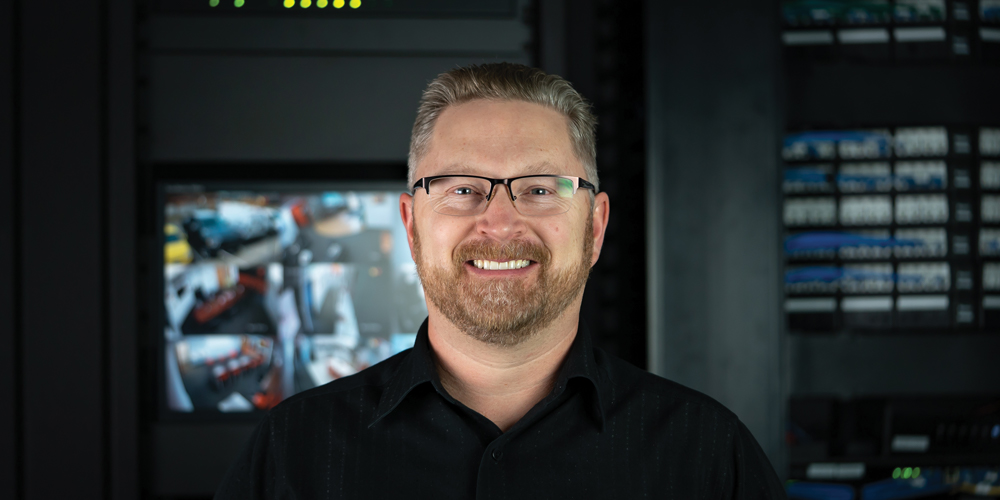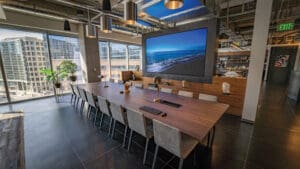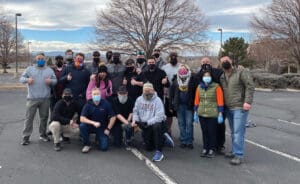They say history repeats itself, and that just might be the case at Logic Integration.
It was more than 12 years ago when founder and CEO Shawn Hansson and Logic Integration – at the time just a custom, high-end residential technology provider in the Denver area – decided a move into the commercial market would help give the company the stability that escapes others. That was in 2008, around the time of the financial collapse and subprime mortgage crisis when home building fell off a cliff. Logic Integration’s move into the commercial market enabled the Lone Tree, Colo.-based company to remain steadfast amid the turmoil.
Fast forward to 2020 and 2021 and this time it’s the commercial market taking a hit caused by the pandemic. Once again Logic Integration’s diverse mix of both commercial and residential clientele has enabled the company to remain stable during the potential chaos. It’s that ingenuity and foresight, among other things, that have earned Logic Integration the 2021 Commercial Integrator of the Year recognition.
Diving into the Commercial Market
Hansson, a San Jose State University graduate with a degree in sound engineering in music, recalls back in 2008 that he had always wanted to move into the commercial market. In the luxury home market, projects tend to get out of hand quickly, with constant change orders, overtime and a project timeline that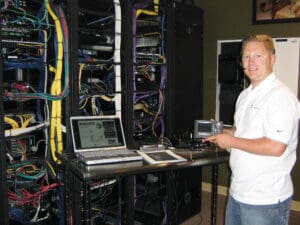 can stretch over multiple years. The customers call for custom installations that can stretch any company to its limits.
can stretch over multiple years. The customers call for custom installations that can stretch any company to its limits.
“In 2008, we kind of saw the writing on the wall and some of our builders started getting a little squeamish,” Hansson says. “That was our chance to slide into the commercial space.”
Now, nearly 12 years later, the company boasts a client base approaching 70% commercial that include state and federal agencies, the U.S. Army, hotels, higher education, hospitals, breweries and more.
That move to heavy commercial and a dedication to the company’s residential roots has boosted the company’s stature, including being named as one of the top 200 private companies in Colorado by ColoradoBiz Magazine.
However clear that decision was to move into the commercial market, it was not an easy decision to make, as some in the company were not on board with sending the company in that direction.
“I grew up in a world where … you do ultra-custom projects, and they’re resume stuffers,” Hansson says.
However, building the “ultimate system” for wealthy customers is time consuming since every project calls for a completely different setup.
While less glamorous than working in the homes of local celebrities and popular athletes, the commercial market provided the company the opportunity to become masters of the products they were selling. It also allowed the company to build packages that can be repeatedly sold and installed without having to learn new custom systems demanded by the customer.
“Can we build the same thing every single time and make money doing it? That was attractive,” Hansson says. “What wasn’t attractive was doing a project that was three-and-a-half years long that had a ton of change orders and going over on hours [in labor].”
Coupled with Hanson’s background in pro audio and mixing tools, Hansson decided it was the right move to dive into the commercial market.
The move required buy in from everyone in the company, but Logic Integration’s top salesperson was not on board. According to Hansson, that salesperson “absolutely refused” to join his vision for the commercial market.
“So, I did one of the toughest things in the world to do,” Hansson recalls. “I cut my top salesperson.”
High-End Corporate Masters
From there, the company hired CTS technicians, engineers, secured financing and started hunting for commercial clients. One of the first such clients that made the transition seem worthwhile was telecommunications giant Comcast.
“We started doing their call centers, video walls and installed some of the first Crestron DM systems with the three cables and the nasty CAT connectors you had to put on and your fingers were bleeding,” Hansson says.
With that dedication to the commercial market, Hansson says his company has become masters of commercial integration. Customers’ AV racks are built and programmed in the company’s shop, making the company’s installation and service time lighting fast.
“High-end corporate is kind of the bread and butter – the thing that we feel we’ve mastered all the way from design, build to support,” Hansson says.
He calls this model the “wash, rinse, repeat” style that helps the company standardize its approaches across customers and vertical markets.
“All the way down from color coding every cable on the rack – the laser labels, power layout and all that stuff – and even in the cloud where we manage all of the equipment,” Hansson says. “We know where the switches are, we know where the amps are and all of that.”
Logic Integration’s COVID response
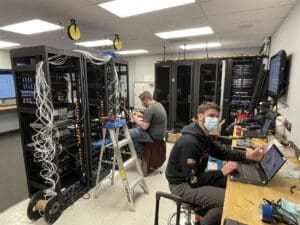 While the company remains steadfastly committed to the commercial market, it was the residential market that saw robust growth over the past two years.
While the company remains steadfastly committed to the commercial market, it was the residential market that saw robust growth over the past two years.
The commercial market took a downturn when the COVID-19 pandemic forced organizations to work remotely, with employees logging on from their homes. Almost overnight, the robust commercial market disappeared, but gave new importance to the residential market.
Luckily for Hansson and Logic Integration, the company was built on the residential market, so it was more than ready to meet the demand for new technologies that customers were asking for while they hunkered down at home.
Related: Could We See the Emergence of Hybrid AV Integrators?
On the strength of Logic Integration’s residential foundation, the pandemic keeping people at home, and a partnership with a production builder, the company’s residential business has grown by about 30% this year.
Commercial, meanwhile, has not fared as well, with renewal contracts and state government work providing some stability for the company.
Like any other integration firm with a strong corporate client base, videoconferencing systems and related upgrades have also provided some cushion.
The company is finding that there isn’t much demand for a residential-commercial crossover for videoconferencing systems, save for some high-level executives who require robust conferencing capabilities in their home offices.
Like any other technology solutions provider, supply chain issues are wreaking havoc to project timelines. However, that hasn’t had an impact on the company’s workload, as there are projects booked through the new year.
“We haven’t had anybody go home early,” Hansson says. “We’re definitely still busy.”
A Commitment to Service
The pandemic gave the company the opportunity to refocus, which included looking at the company’s customers from the past few years and sorting them by profitability. That helped identify where the revenue opportunities were and where their efforts could be shifted.
That refocusing effort also included more investment in the company’s managed services and recurring revenue. That included shifting recurring revenue operations to a more secure and automated platform, but also growing the service department.
“Our service department has tripled in size and revenue,” Hansson says.
The company decided early on in its commercial venture that its service department would have to be top notch to respond to any concerns or outages at a moment’s notice, with a company requirement that support calls are responded to in less than five minutes.
Read: Why You Should Offer Managed Services for Client Retention
According to Hansson, that is what sets the company apart from its competitors.
“When someone spends half-a-million dollars on AV and after the last check is written, it’s not a great feeling for them to call their integrator with a question and not get call you back for a few days,” he says.
In the midst of the pandemic, that commitment to quality and timely service led to upgrade projects and renewals with those more profitable customers. Simple things like software upgrades, projector cleaning and other maintenance both helped the company retain the trust of its longtime customers, but also helped to pad the firm’s revenue.
Hansson is excited about achieving rapid growth in recurring revenue and service contracts, with over 50% service growth this year. However, he is aiming even higher next year, eyeing 100% growth in 2022.
The past two years have illustrated why managed services and recurring revenue are critical for any technology solutions provider, with a healthy backlog of projects no longer a certainty.
“Jobs come and go, and you’re not going to collect that money forever,” Hansson says.
Responding to an Inflection Point in AV
As AV systems are increasingly deployed on the network and managed via the cloud, AV is now a subset of IT, with internal IT teams increasingly taking it upon themselves to deploy and manage audiovisual systems.
Hansson sees that occurring more often now, with corporate clients enlisting their IT departments to deploy their own conferencing systems. That is especially true as margins on hardware get slimmer and slimmer and “black boxes” become a commodity.
“They could take a Crestron Flex and they could put it online, go to the web interface and go, ‘Okay, I just need to name this here,’” Hansson says. “That’s definitely a huge threat.”
Where integrators can continue to provide value, however, is with a dedicated service team that is highly specialized in troubleshooting and fixing those systems.
In addition, those systems need to be easy to use. That’s where the company’s residential roots are bleeding over into the commercial market. In the smart home market, automation and ease of use are key to keeping customers happy. Especially for conferencing solutions, that simplicity is becoming the norm in corporate offices as well, since end users became accustomed to using solutions like Zoom, Microsoft Teams and Cisco Webex from their laptops.
Related: BYOD Systems Are Wildly Popular Right Now
That was exemplified in one project where Logic Integration’s corporate customer was standardized on Cisco Webex across the board.
The customer had large meeting spaces and wanted the Webex interface to run all of the Crestron and QSC solutions behind the scenes so users don’t have to learn a new graphical user interface when they use the systems.
“One-touch meetings were so important to them that they wanted to pay for it,” Hansson says.
According to Hansson, the company has processed almost 3,000 support tickets this year. If a large majority of those tickets result in billable hours, that provides a solid revenue stream.
That’s why a top-notch service and support team is becoming central for today’s audiovisual integration business. Building integrated audiovisual systems remains what makes this industry unique. But when it breaks and the only person who can fix it is booked for three weeks, customers are left unhappy.
“People want to be in control of their own destiny,” Hansson says.
Culture Sets Logic Integration Apart
Aside from service and a solid background of both commercial and residential projects, Colorado-based audiovisual service provider Logic Integration prides itself on its culture and management style built on a foundation of trust.
Making sure his employees enjoy coming to work is an important part of founder and CEO Shawn Hansson’s job, the business owner told Commercial Integrator. Culture is so important to him that the company has hired an outside consultant to study the company’s culture and core values.
“We’ve always had a mission and vision and all that kind of stuff, but it’s about getting everybody to actually know what it is and why we’re doing it,” Hansson says.
The company leader makes regular employee engagement and team bonding a priority, with group outings to Moab, Utah for an ATVing excursion and sumo suit wrestling just a few recent examples of how the company values building what Hansson calls a “killer culture.”
To understand why the company operates this way, one needs to only look at Hansson’s career path. He grew up as an audiophile working in a recording studio, started fixing computers and was offered a job in the residential market in California. The company then moved to Denver, but two months later, the owner couldn’t afford payroll, so Hansson took a job at another AV installer.
However, he soon found out that the company was dishonest, installing used equipment at new prices. When a customer complained about malfunctioning equipment, Hansson told the customer the truth.
That customer – along with several others – told Hansson that they would give him business if he left the company and started his own. So, he did.
Related: These 6 Elements Make Company Culture Better
That focus on culture has even led the company to be a bit picky when deciding to pick up a new customer. According to Hansson, the company studies a potential customer’s online reviews from Google and Glassdoor to learn about their culture.
Without naming names, Hansson says the company has told some of its customers to look elsewhere for AV services after seeing how they treat IT staff and other employees.
“It’s been hard,” Hansson says. “Some of these customers generate some pretty decent revenue, but man, when they start telling at your staff and you have a miserable IT manager over there, it’s time to cut them loose.”
The COVID-19 pandemic gave the company a chance to step back and focus on its employees rather than constant growth at the expense of its employees’ wellbeing.
That has included opening up the company’s books to its employees and setting up some profit-sharing opportunities designed to help employees buy in to managed services and recurring revenue contracts.
“We’re stepping back from COVID to focus on that instead of grow, grow, grow,” Hansson says. “Ultimately, we all want a place that we enjoy working at. I think sometimes we can be driving the top line so much that we lose track of that.”

